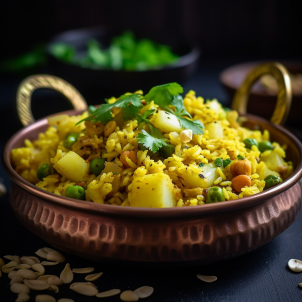
Introduction:
Poha, also known as flattened rice, is a staple breakfast dish in many regions of India, and for good reason. This versatile grain is not just a source of wholesome nutrition, but it also brings a delightful texture and flavor to every dish it's part of. But the benefits of Poha extend beyond its taste; it also offers numerous health advantages over traditional rice varieties.
Understanding Poha:
Poha originates from the rice plant, but its processing method differs from typical rice. The rice is parboiled, then rolled, flattened, and finally dried to create light, flaky grains. These flakes can be consumed raw or cooked, and their mild flavor makes them a suitable addition to various recipes.
Health Benefits of Poha:
Low in Calories: Poha is a low-calorie food, making it a perfect choice for those watching their calorie intake. It is filling and can be easily incorporated into weight loss diets.
Easily Digestible: Poha is light on the stomach and easy to digest. It is often recommended for people with digestive problems as it does not cause bloating or gas, unlike certain other grains.
Rich in Iron: Poha is a good source of iron, which is essential for maintaining healthy red blood cells and preventing conditions like anemia. Some versions of poha are even iron-fortified for additional benefits.
Good Source of Carbohydrates: Poha is a slow-releasing carbohydrate, which means it helps in the gradual release of sugar into the bloodstream. This can prevent sudden spikes in blood sugar levels, making it a good choice for diabetics.
Low in Gluten: For those with gluten sensitivity or celiac disease, poha offers a great alternative. It contains significantly less gluten than many other grains.
Packed with Fiber: Poha is rich in fiber, promoting better digestion and aiding in weight loss by keeping you fuller for longer.
Poha Vs. Rice:
While rice is a staple food in many diets worldwide, it has certain limitations. White rice, in particular, can cause a quick rise in blood sugar levels, leading to an energy crash later on. It is also low in fiber and can contribute to digestive issues when consumed in large quantities.
On the other hand, Poha has a low to medium glycemic index, which signifies a slower and more balanced release of sugar into the bloodstream. This can help in managing blood sugar levels and maintaining sustained energy throughout the day.
Furthermore, the process that transforms rice into Poha maintains many of the original nutrients while reducing the calories and carbohydrates present in the final product. This makes Poha a lighter, more diet-friendly choice.
Conclusion:
While both rice and Poha come from the same source, they differ significantly in nutritional content and health impacts. Poha stands out as a healthier alternative to rice, offering a host of benefits from iron-rich content to easy digestibility, and lower calorie count.
So next time you’re thinking about a healthy, delicious meal option, don't hesitate to reach for Poha. This versatile grain can be used in a variety of dishes, offering a satisfying texture and flavor, while also supporting your health goals.
Remember, the key to a healthy diet is balance. Poha can certainly be an excellent part of a balanced, nutritious diet, but it’s equally important to include a variety of other whole grains, fruits, vegetables, lean proteins, and healthy fats in your meals.
Happy eating!
